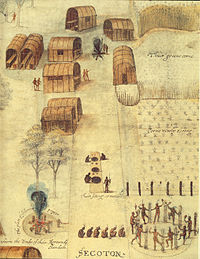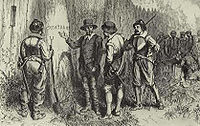- Croatan
-
Croatan Total population Extinct as a tribe Regions with significant populations North Carolina Languages Carolina Algonquian
Religion Tribal religion
Related ethnic groups Roanoke
The Croatan were a small Native American group living in the coastal areas of what is now North Carolina. They may have been a branch of the larger Roanoke people or allied with them.[1]
The Croatan lived in current Dare County, an area encompassing the Alligator River, Croatan Sound, Roanoke Island, and parts of the Outer Banks, including Hatteras Island. Now extinct as a tribe, they were one of the Carolina Algonquian peoples, numerous at the time of English encounter in the 16th century. The Roanoke territory also extended to the mainland, where they had their chief town on the western shore of Croatan Sound. Scholars believe the Algonquians had a total population of 5,000 to 10,000.[1]
The Roanoke and Croatan were believed to have been on good terms with English settlers of the Roanoke Colony. Wanchese, the last leader of the Roanoke, accompanied the English on a trip to England.
The Croatan, like other Carolina Algonquians, suffered from epidemics of infectious disease, such as smallpox in 1698. These decimated the tribes and left them subject to colonial pressure. They are believed to have become extinct as a tribe by the early seventeenth century.
Contents
Nineteenth century claims
Based on legend, some people said that the Lumbee tribe, based in North Carolina, were descendants of the Croatoan and survivors of the Lost Colony of Roanoke Island. There is no substantive historical evidence for this.
More recently the Lumbee have claimed descent from the Cheraw, a Siouan-speaking people. There is no direct historical evidence of this connection. The evidence available seems to indicate that the Lumbee may have some individual ancestors among certain Siouan tribes, who came together in the nineteenth century.[citation needed]
Late twentieth-century research has demonstrated that among surnames established as Lumbee ancestors were numerous mixed-race African Americans free in Virginia before the American Revolution, and their descendants who migrated to the Virginia and North Carolina frontiers in the late eighteenth and early nineteenth centuries. These "free people of color" were mostly descendants of white women and African men, who worked and lived together in colonial Virginia. These connections have been traced for numerous individuals and families through court records, land deeds and other existing historical documents.[2][3] In Robeson County, they may have intermarried with Native American survivors and acculturated as Indian.
The Lost Colony
It is possible that some of the survivors of the Lost Colony of Roanoke may have joined the Croatan. Governor White finally reached Roanoke Island on August 18, 1590, three years after he had last seen them in Virginia, but he found his colony had been long deserted. The buildings had collapsed and "the houses [were] taken downe".[4] The few clues about the colonists whereabouts included the letters "CRO" carved into a tree, and the word "CROATOAN" carved on a post of the fort.[4] Croatoan was the name of a nearby island (likely modern-day Hatteras Island) and a local tribe of Native Americans. Roanoke Island was not originally the planned location for the colony and the idea of moving elsewhere had been discussed. Before the Governor's departure, he and the colonists had agreed that a message would be carved into a tree if they had moved and would include an image of a Maltese Cross if the decision was made by force.[4] White found no such cross and was hopeful that his family was still alive.[5]
The Lost Colony Center for Science and Research has excavated English artifacts within the territory of the former Croatan tribe. The artifacts may also be evidence of trade with the tribe, or of Indians' finding them at the former colony site. The Center is conducting a DNA study to try to determine if there are European lines among Croatan descendants.
See also
- Algonquian languages
- Algonquian peoples
- Aquascogoc
- Carolina Algonquian
- Dasamongueponke
- Roanoke tribe
- Secotan
Notes
- ^ a b "Indian Towns and Buildings of Eastern North Carolina", Fort Raleigh National Historic Site, National Park Service, 2008, accessed 24 Apr 2010
- ^ Paul Heinegg, Free African Americans of Virginia, North Carolina, South Carolina, Maryland and Delaware, 2005, accessed 15 Feb 2009
- ^ J. Cedric Woods, "Lumbee origins: The Weyanoke-Kearsey connection", Southern Anthropologist, 2004, accessed 30 Jul 2008
- ^ a b c Milton, p.265
- ^ Milton, p.266
References
- K.I. Blu: "Lumbee", Handbook of North American Indians, vol. 14: 278-295, Washington, DC: Smithsonian Institution, 2004
- T. Hariot, J. White, J. Lawson: A vocabulary of Roanoke, Merchantville: Evolution Publishing, 1999
- Milton, Giles, Big Chief Elizabeth - How England's Adventurers Gambled and Won the New World, Hodder & Stoughton, London (2000)
- Th. Ross: American Indians in North Carolina, South Pines, NC: Karo Hollow Press, 1999
- G.M. Sider: Lumbee Indian histories, Cambridge: Cambridge University Press, 1993
- S.B. Weeks: The lost colony of Roanoke, its fate and survival, New York: Knickbocker Press, 1891
- J.R. Swanton: "Probable Identity of the Croatan Indians." U.S. Dept. of the Interior, Office of Indian Affairs, 1933
- J. Henderson: "The Croatan Indians of Robeson County, North Carolina", U.S. Dept. of the Interior, Office of Indian Affairs, 1923
Categories:- Pre-state history of North Carolina
- Native American history
- Native American tribes in North Carolina
- Native American history of North Carolina
- Algonquian ethnonyms
Wikimedia Foundation. 2010.


